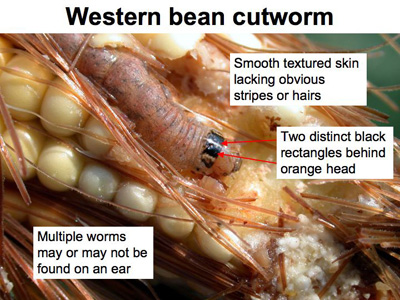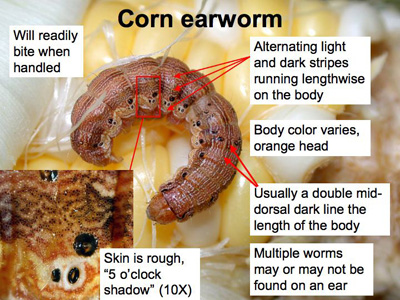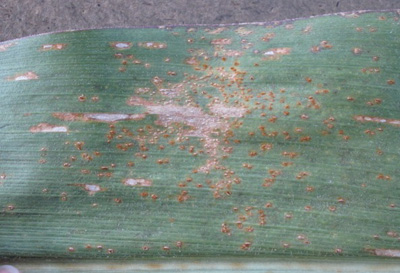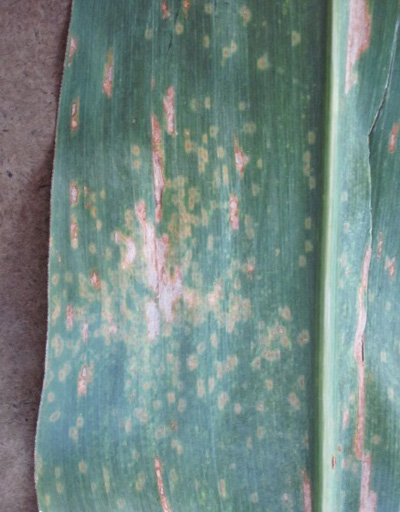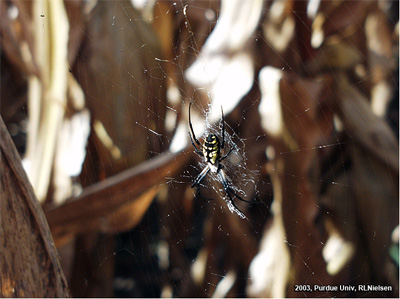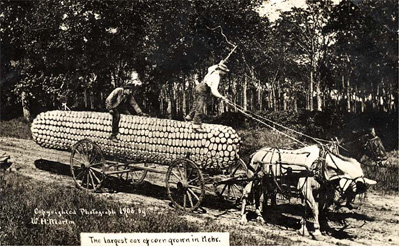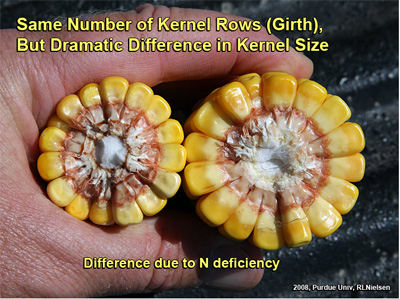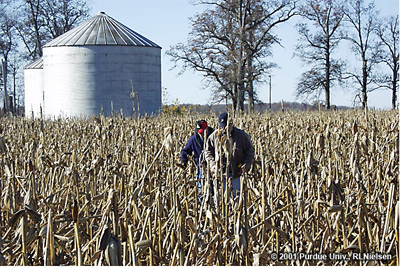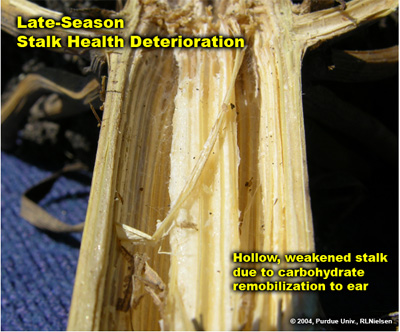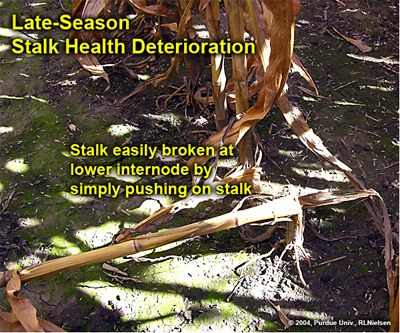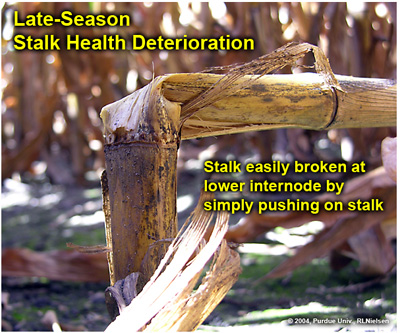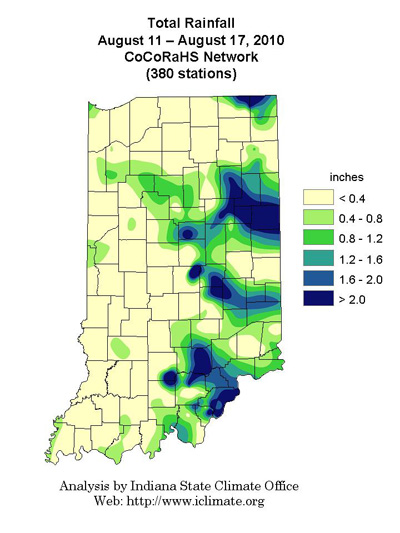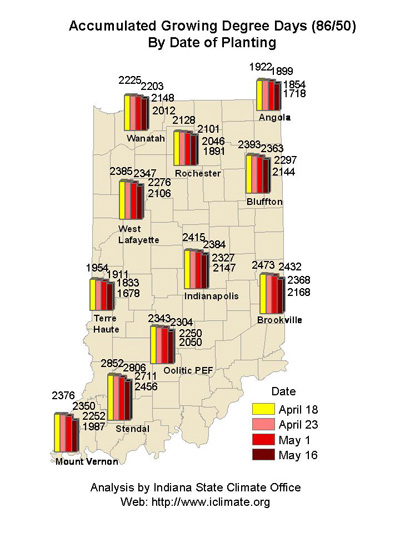Pest & Crop Newsletter, Entomology Extension, Purdue University
- Help Us Identify Western Bean Cutworm Damage Range
- Corn Earworm Moth Flight Quite Impressive
- Black Light Trap Catch Report
- VIDEO: Soybean Full Seed (R6) Growth Stage
- VIDEO: Soybean Late Season Stresses
- Walk Corn Hybrid Plots in August
- Estimating Corn Grain YUield Prior to Harvest
- Stress During Grain Fill: Harbinger of Stalk Health Problems
Help Us Identify Western Bean Cutworm Damage Range – (Christian Krupke and John Obermeyer)
We appreciate the efforts of many that are monitoring for western bean cutworm (WBC) damage and notifying us of infested areas. The map below shows the known distribution of larvae and their damage as of this writing. Please let us know if you find an infestation in a county not yet identified.
It is likely that most damaged ears will be noticed near, or at, harvest time. At that time, the culprit will be gone, buried in the soil to overwinter. Therefore, there is no way to be certain that other ear-feeding caterpillars e.g., corn earworm, fall armyworm, didn’t cause that damage. The bottom line here is that our time for confirming WBC damage is soon ending, so the time is now to scout suspect fields and look for the larvae. The damage alone is NOT diagnostic and infestations are extremely patchy so a good subsampling of different field areas is essential.
Please contact John Obermeyer: obe@purdue.edu, 765-494-4563 with updates to counties with WBC damage.
Known counties with WBC infestations
![]()
Corn Earworm Moth Flight Quite Impressive – (Christian Krupke and John Obermeyer)
Corn earworm moth numbers have surged in pheromone traps throughout the state. Please check the 2010 Corn Earworm Pheromone Trap Catches <http://extension.entm.purdue.edu/cornearworm/index.php>. These moths will lay their eggs on numerous crops, with late-market sweet corn or late-planted seed corn being particularly vulnerable at this time. Tomato and pepper growers should also be aware of the potential for earworm (also called fruitworm) damage, especially if these crops are surrounded by cornfields that are drying down are no longer attractive for egg laying.
Corn earworm and their damage can often be mistaken for western bean cutworm. The following graphics may help in differentiating the two:
![]()
Click here to view the Black Light Trap Catch Report
Southern Corn Rust Confirmed in Indiana – (Kiersten Wise)
Southern corn rust, caused by the fungus Puccinia polysora, was confirmed in Jennings, Knox, Tippecanoe, Posey, and Vanderburgh counties over the last week. The disease was observed at low incidence and severity in confirmed fields. It is possible that southern corn rust is present in fields in other counties in Indiana, however, the majority of corn in Indiana is at a growth stage where the current levels of southern rust will not impact yield.
Southern corn rust should not be confused with common rust of corn, which is typically found in Indiana cornfields, and caused by the fungus Puccinia sorghi. The location, color, and shape of the pustules are important for identifying the type of rust infection. Common rust pustules are present on upper and lower leaf surfaces, typically brownish-red, elongated in shape, and scattered on the leaf surfaces (Figure 1). Southern rust pustules are located primarily on the upper leaf surface, orange to light brown, round, and densely packed on the leaf surface (Figure 2). Mixed infections of both rust fungi can occur on the same plant, which can confuse diagnosis.
Neither rust fungus survives Indiana winters. Each year, spores of both rusts are blown north from tropical areas on wind currents and deposited into Indiana cornfields. The movement of southern rust northward can be tracked on the IPM PIPE website: <http://sba.ipmpipe.org/cgi-bin/sbr/public.cgi?host=Corn&pest=southern_corn_rust>.
Both rust fungi require short periods of leaf wetness to cause infection, and temperature plays a critical role in the life cycle of both rusts. The common rust fungus prefers cooler weather (61-77°F) for optimal infection. Common rust symptoms may be observed early in the season, depending on how quickly spores arrive from the south. Cool evenings with dew formation can lead to severe common rust on susceptible hybrids and inbreds. Southern rust prefers warmer weather, and fungal infection occurs between 77-82°F. This disease usually appears in Indiana in late August or September.
Southern rust has the greatest potential to damage yields if it reaches Indiana at a critical point in the growing season. Planting corn as early as possible can minimize disease risk later in the season, because leaves will typically be more mature and less susceptible to infection when rust spores arrive from the South. Fungicides are available for in-season rust management; however the majority of Indiana corn in 2010 will not likely experience yield loss due to southern rust. Late-planted corn should be scouted for the disease, and suspect samples can be submitted to the Purdue Plant and Pest Diagnostic Lab if confirmation is needed.
Figure 1. Common rust pustules are brown to reddish brown, elongated, and scattered on the leaf surface.
Figure 2b. Southern rust pustules are orange to brown, small, and densely packed on the upper leaf surface. The lower surface of infected leaves have chlorotic flecking present, but do not have prominent pustules.
![]()
Soybean Disease Update – (Kiersten Wise)
A variety of soybean diseases have been observed in Indiana over the last two weeks. Early symptoms of Sudden death syndrome, or SDS, were present in northwest and central Indiana as early as late July, and discussed in a previous newsletter article: <http://extension.entm.purdue.edu/pestcrop/2010/issue18/index.html#sudden>. Symptoms of the disease in these areas have progressed over the last few weeks. Fields in central and southern Indiana are also showing symptoms of the disease. Late-planted fields appear to have less of the disease than April or early May plantings.
Brown stem rot has also been identified in several fields in Indiana. Foliar symptoms of this disease can resemble foliar symptoms of SDS and it is important to split the lower stem of symptomatic plants to determine which fungal disease is present. BSR can cause internal stem browning, resulting in a dark brown discoloration of the pith at the lower nodes of the plant. The pith of plants affected by SDS will remain white, while the tissue below the epidermis will have brown to gray discoloration present.
Frogeye leaf spot is also present in fields in central and northeastern Indiana. This foliar disease of soybean is caused by the fungus Cercospora sojina. This disease can be moderate to severe in susceptible varieties, and during periods of warm and humid weather. Resistant varieties are available, and foliar fungicides can be used to manage the disease. However, thresholds for fungicide applications have not yet been established, and profitability of a fungicide application will depend on timing of disease onset, level of disease within a field, variety susceptibility, growth stage, and economic factors.
White mold has also been observed in areas within the state. Although it can be found in fields here and there, overall the distribution and severity of the disease is well below the levels observed in 2010.
For more information about the diseases listed here, please check the following Purdue Extension bulletins:
Sudden Death Syndrome of Soybean: <http://www.ces.purdue.edu/extmedia/BP/BP-58-W.pdf>
Brown Stem Rot of Soybean: <http://www.ces.purdue.edu/extmedia/BP/BP-41-W.pdf>
Frogeye Leaf Spot of Soybean: <http://www.ces.purdue.edu/extmedia/BP/BP-131-W.pdf>
White mold of Soybean: <http://www.ces.purdue.edu/extmedia/BP/BP-131-W.pdf>.
VIDEO: Soybean Full Seed (R6) Growth Stage – (Shaun Casteel)
Soybean yields are determined throughout the growing season, but the most critical is during the reproductive development. Eighty-three percent of Indiana’s soybeans are setting pods (and filling seeds) according to the August 15th USDA-NASS Crop Progress Report. This video demonstrates how to determine the full seed (R6) growth stage of soybean, which is when the total pod weight is maximized and the rate of dry weight and nutrient accumulation slows.
![]()
VIDEO: Soybean Late Season Stresses – (Shaun Casteel)
Stress during seed fill of soybean can cause significant yield reductions. Temperatures in the low 70s at night and 80s during the day provide excellent conditions for seed fill. Heat stresses (>90° days, >75° nights) to soybean typically shorten the seed fill period and not the rate of seed fill per day unless water becomes limiting. Additional stresses are showing up across the state including Sudden Death Syndrome and Brown Stem Rot, which look very similar and scouting will help to determine management decisions in the following years.
![]()
Walk Corn Hybrid Plots in August – (Bob Nielsen)
“Choosing hybrids wisely may be one of the most important decisions you make that influence the profitability of next year’s corn crop!” - Some smart corn guy told me that.
Make the effort during the “dog days” of late August to visit nearby seed company test plots and write down your own notes on hybrid characteristics that may help your decision-making process later on in the fall. Don’t wait for the seed company field day. Stop by any variety test plot that is “signed” by the seed rep. The presence of hybrid signs is your invitation to stop and walk the plots.
Test plots are great for evaluating heritable traits like plant or ear height, husk coverage, disease resistance, stalk health and integrity, and overall plant health. If the growing season has been overly dry, look at the success or lack thereof in kernel set or kernel depth on the ears. If the conditions have been conducive for foliar diseases, compare the severity of leaf disease among the hybrids. If the grain fill period has experienced serious stress, look for evidence of hybrid differences for stalk cannibilization or stalk rot.
A garden spider on the prowl
When you attend seed company field days late in the summer, make the effort not to be a passive observer and listener. Speak up and ask the hard questions about disease resistance, stalk health, emergence vigor, drought tolerance, “wet feet” tolerance, consistency of yield potential across varied environments, and other important hybrid characteristics that may not be addressed at the field day stops or in the sales literature handed out at the field day. If you don’t understand the hoopla over the many and varied biotech traits, then be sure to ask for explanations.
Two Pieces of Advice
If you do not know whether a variety test plot was sprayed with a foliar fungicide earlier in the season, then be cautious with your evaluations of apparent differences among hybrids for severity of leaf diseases like gray leaf spot.
Keep an eye out for those big d*** garden spiders and their webs as you walk through variety plots in August. In my mind, they are in the same category as tarantulas!
Related Reading
Nielsen, R.L. (Bob). 2009. Hybrid Selection: Where’s the Beef? Corny News Network, Purdue Univ. [online] <http://www.kingcorn.org/news/timeless/HybridSeln.html> [URL accessed Aug 2010].
![]()
Estimating Corn Grain Yield Prior to Harvest – (Bob Nielsen)
Fancy colored yield maps are fine for verifying grain yields at the end of the harvest season, but bragging rights for the highest corn yields are established earlier than that down at the Main Street Cafe, on the corner of 5th and Earl. Some patrons of the cafe begin “eyeballing” their yields as soon as their crops reach “roasting ear” stage. Some of the guys there are pretty good (or just plain lucky) at estimating yields prior to harvest, while the estimates by others are not even close to being within the proverbial ballpark. Interestingly, they all use the same procedure referred to as the Yield Component Method.
Largest ear of corn in Nebraska ca. 1908. Courtresty of the Neb. Historical Society
Other pre-harvest yield prediction methods exist (Lauer, 2002; Thomison, 2010), but the Yield Component Method is probably the most popular because it can be used well ahead of harvest; as early as the so-called “roasting ear” or milk (R3) stage of kernel development. Under “normal” conditions, the kernel milk stage occurs about 18 to 22 days after pollination is complete (Nielsen, 2008a). Estimates made earlier in the kernel development period risk being overly optimistic if subsequent severe stresses cause unforeseen kernel abortion (Nielsen, 2009).
The Yield Component Method was originally described by the University of Illinois many years ago and is based on the premise that one can estimate grain yield from estimates of the yield components that constitute grain yield. These yield components include number of ears per acre, number of kernel rows per ear, number of kernels per row, and weight per kernel. The first three yield components (ear number, kernel rows, kernels/row) are easily measured in the field.
Final weight per kernel obviously cannot be measured until the grain is mature (kernel black layer) and, realistically, at harvest moisture. Consequently, an average value for kernel weight, expressed as 85,000 kernels per 56 lb bushel, is used as a proverbial “fudge factor” in the yield estimation equation. The equation originally used a “fudge factor” of 90, but kernel size has increased as hybrids have improved over the years; so a “fudge factor” of 85 is a more realistic value to use today.
Crop uniformity greatly influences the accuracy of any yield estimation technique. The less uniform the field, the greater the number of samples that should be taken to estimate yield for the field. There is a fine line between fairly sampling disparate areas of the field and sampling randomly within a field so as not to unfairly bias the yield estimates up or down.
At each estimation site, measure off a length of row equal to 1/1000th acre. For 30-inch (2.5 feet) rows, this equals 17.4 feet.
TIP: For other row spacings, divide 43,560 by the row spacing (in feet) and then divide that result by 1000 (e.g., [43,560/2.5]/1000 = 17.4 ft).
Count and record the number of ears on the plants in the 1/1000th acre of row that you deem to be harvestable.
TIP: Do not count dropped ears or those on severely lodged plants unless you are confident that the combine header will be able to retrieve them.
For every fifth ear in the sample row, record the number of complete kernel rows per ear and average number of kernels per row. Then multiply each ear’s row number by its number of kernels per row to calculate the total number of kernels for each ear.
TIP: Do not sample nubbins or obviously odd ears, unless they fairly represent the sample area. If row number changes from butt to tip (e.g., pinched ears due to stress), estimate an average row number for the ear. Don’t count the extreme butt or tip kernels, but rather begin and end where you perceive there are complete “rings” of kernels around the cob. Do not count aborted kernels. If kernel numbers are uneven among the rows of an ear, estimate an average value for kernel number per row.
Calculate the average number of kernels per ear by summing the values for all the sampled ears and dividing by the number of ears.
EXAMPLE: For five sample ears with 480, 500, 450, 600, and 525 kernels per ear, the average number of kernels per ear would be (480 + 500 + 450 + 600 + 525) divided by 5 = 511.
Estimate the yield for each site by multiplying the ear number by the average number of kernels per ear, then dividing that result by 85. The value of “85” represents the average number of kernels (85,000) in a bushel of corn.
TIP: Use smaller values (e.g., 75 - 80) if grain fill conditions have been excellent (larger kernels, fewer per bushel) or a larger value (e.g., 95 - 100) if grain fill conditions have been stressful (smaller kernels, more per bushel).
Example: Let’s say you counted 30 harvestable ears at the first thousandth-acre sampling site. Let’s also assume that the average number of kernels per ear, based on sampling every 5th ear in the sampling row, was 511. The estimated yield for that site would (30 x 511) divided by 85, which equals 180 bu./ac.
Repeat the procedure throughout field as many times as you deem to be representative. Calculate the average yield for all the sites to estimate the yield for the field.
Random sample of ears
Poor tip fill due to N deficiency
Kernel size differences due to N deficiency
Remember that this method for estimating pre-harvest grain yield in corn indeed provides only an estimate. Since kernel size and weight will vary depending on hybrid and environment, this yield estimator should only be used to determine “ballpark” grain yields. Yield will be overestimated in a year with poor grain fill conditions (e.g., low kernel size and weight from a drought year) and underestimated in a year with excellent grain fill conditions (e.g., larger kernel size and weight from non-stress grain fill periods).
Recognize that the Yield Component Method for estimating corn grain yield is probably only accurate within plus or minus 30 bushels of the actual yield. Obviously, the more ears you sample within a field, the more accurately you will “capture” the variability of yield throughout the field. Use the yield estimates obtained by this method for general planning purposes only.
Related Reading
Lauer, Joe. 2002. Methods for Calculating Corn Yield. Agronomy Advice, Univ. of Wisconsin-Madison. [On-Line]. Available at <http://corn.agronomy.wisc.edu/AA/pdfs/A033.pdf> [URL accessed Aug 2010].
Lee, Chad and Jim Herbek. Estimating Corn Yields (AGR-187). Univ. of Kentucky. [On-Line]. Available at <http://www.ca.uky.edu/agc/pubs/agr/agr187/agr187.pdf>. [URL accessed Aug 2010].
Nielsen, R.L. (Bob). 2008a. Grain Fill Stages in Corn. Corny News Network, Purdue Univ. [On-Line]. Available at <http://www.kingcorn.org/news/timeless/GrainFill.html> [URL accessed Aug 2010].
Nielsen, R.L. (Bob). 2008b. Kernel Set Scuttlebutt. Corny News Network, Purdue Univ. [On-Line]. Available at <http://www.kingcorn.org/news/timeless/KernelSet.html> [URL accessed Aug 2010].
Nielsen, R.L. (Bob). 2009. Effects of Stress During Grain Filling in Corn. Corny News Network, Purdue Univ. [On-Line]. Available at <http://www.kingcorn.org/news/timeless/GrainFillStress.html> [URL accessed Aug 2010].
Thomison, Peter. 2010. “Predicting” Corn Yields Prior to Harvest. C.O.R.N. Newsletter, Ohio State Univ. [On-Line]. Available at <http://corn.osu.edu/newsletters/2010/2010-25/201cpredicting201d-corn-yields-prior-to-harvest> [URL accessed Aug 2010].
![]()
Stress During Grain Fill: A Harbinger of Stalk Health Problems – (Bob Nielsen)
Harbinger. [hahr-bin-jer] Anything that foreshadows a future event; omen; sign: Frost is a harbinger of winter.
Dictionary.com. Unabridged (v 1.1). Random House, Inc.
<http://dictionary.reference.com/browse/harbinger> (accessed: September 01, 2008).
During the grain filling period of corn, developing kernels become a significant photosynthetic “sink” for the products of photosynthesis and respiration. Corn plants prioritize the movement of these photosynthates to the kernels, even at the expense of not maintaining the cellular health of the stalk, leaves, and roots.
The primary effect of severe stress on a corn plant (drought, heat, nutrient deficiency, leaf diseases, insect damage, hail damage, consecutive days of cloudy weather) is a reduction in photosynthetic rates. If photosynthetic capacity decreases significantly during grain fill, plants often respond by remobilizing stored carbohydrates from stalk and leaf tissues to supply the intense physiological demand by the developing grain on the ears. In addition to physically weakening the stalk of plants, remobilization of stored carbohydrates and/or the consequent lower cellular maintenance of root and stalk tissues increases the susceptibility of the plant to root and stalk rots.
NOTE: Even if significant stalk rot does not develop in such stressed plants, loss of structural stalk integrity itself greatly increases the risk of stalk breakage.
Fields at higher risk for weakened stalks and stalk rot development will be those where plants have managed to set fairly decent ears but have experienced severe stress during grain fill. Common photosynthetic stresses that occur during grain filling in Indiana include drought stress, nitrogen deficiency, and foliar leaf diseases. The effects of dry weather during August on corn stalk health are accentuated where compacted soils restricted root growth earlier in the season or on sandy soils with minimal water-holding capacity.
Growers should monitor stressed fields in late August and early September for compromised stalk strength or the development of severe stalk rots and adjust their harvest schedules accordingly to harvest these fields early in the season to avoid the consequences of severe stalk lodging. In years where crop development is delayed, like in 2009, stalk quality problems often are not apparent until mid- to late September.
Stalk breakage itself is obviously easy to spot when scouting a field. However, compromised stalks may stand unnoticed until that October storm front passes through and brings them to their proverbial knees. The simplest techniques for identifying suspect stalk quality involve either pushing on stalks to see whether they will collapse or bending down and pinching the lower stalk internodes to see whether they collapse easily between your fingers. Sometimes the mere act of pushing stalks out of your way as you walk from one row of corn to another is enough force to collapse weakened stalks.
TIP: Bending down repeatedly to pinch lower stalk internodes qualifies as an aerobic exercise.
Fields and/or hybrids at high risk of stalk breakage should be harvested as early as possible to minimize the risk of significant mechanical harvest losses. Recognize that hybrids can vary greatly for late-season stalk quality even if grown in the same field due to inherent differences for late-season plant health or resistance against carbohydrate remobilization when stressed during grain fill.
Another side-effect of late-season stress during grain fill is the greater risk of premature kernel black layer formation. In 2009, foliar diseases like gray leaf spot (Cercospora zeae-maydis) and northern corn leaf blight (Exserohilum turcicum) developed late in the season (some say, exploded) and destroyed much if not all of the green leaf tissue before the grain had matured. Such destruction of green leaf tissue, in addition to encouraging the remobilization of stored carbohydrates from the lower stalks, also predisposes the grain to premature kernel black layer formation. The consequences of premature kernel black layer include not only lower grain yield, but also the likelihood of lower test weight grain.
Related Reading
Jackson, Tamra. 2009. Stalk Rots Already a Problem in Some Nebraska Fields. CropWatch Newsletter. Univ. of Nebraska. [online] <http://cropwatch.unl.edu/web/cropwatch/archive?articleId=1499298>. [URL accessed Aug 2010].
Lee, Chad . 2007. Weak Corn Stalks from Drought. Corn & Soybean News, Univ. of Kentucky. [online] <http://www.uky.edu/Ag/CornSoy/cornsoy7_7.htm> [URL accessed Aug 2010].
Mills, Dennis, Pierce Paul, and Peter Thomison. 2006. Corn Stalk Rot: A Disease Caused by Several Different Fungi. C.O.R.N. Newsletter, Ohio State Univ. [online] <http://corn.osu.edu/newsletters/2006/article?issueid=155&articleid=932> [URL accessed Aug 2010].
Nielsen, R.L. (Bob). 2008. Grain Fill Stages in Corn. Corny News Network, Purdue Univ. [online] <http://www.kingcorn.org/news/timeless/GrainFill.html> [URL accessed Aug 2010].
Nielsen, R.L. (Bob) 2009. Effects of Stress During Grain Filling in Corn. Corny News Network, Purdue Univ. [online] <http://www.kingcorn.org/news/timeless/GrainFillStress.html> [URL accessed Aug 2010].
Shaner, G. and D. Scott. 1998. Stalk Rots of Corn. Purdue Univ. Extension Publication BP-59. Available online at <http://www.ces.purdue.edu/extmedia/BP/BP-59.pm65.pdf> [URL accessed Aug 2010].
Thomison, Peter, Pierce Paul, and Dennis Mills. 2008. Dry Weather May Lead to Stalk Lodging Problems in Corn. C.O.R.N. Newsletter, Ohio State Univ. [online] <http://corn.osu.edu/newsletters/2008/article?issueid=248&articleid=1559> [URL accessed Aug 2010].
Vincelli, Paul. 2004. Factors That Could Enhance Stalk Rots in Corn. Kentucky Pest News (Aug 2). Univ. of Kentucky. Available online at <http://www.uky.edu/Agriculture/kpn/kpn_04/pn040802.htm#corrot> [URL accessed Aug 2010].


